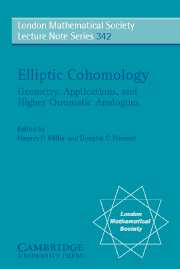Book contents
- Frontmatter
- Contents
- Preface
- Charles Thomas, 1938–2005
- 1 Discrete torsion for the supersingular orbifold sigma genus
- 2 Quaternionic elliptic objects and K3-cohomology
- 3 The M-theory 3-form and E8 gauge theory
- 4 Algebraic groups and equivariant cohomology theories
- 5 Delocalised equivariant elliptic cohomology (with an introduction by Matthew Ando and Haynes Miller)
- 6 On finite resolutions of K(n)-local spheres
- 7 Chromatic phenomena in the algebra of BP*BP-comodules
- 8 Numerical polynomials and endomorphisms of formal group laws
- 9 Thom prospectra for loopgroup representations
- 10 Rational vertex operator algebras
- 11 A possible hierarchy of Morava K-theories
- 12 The motivic Thom isomorphism
- 13 Toward higher chromatic analogs of elliptic cohomology
- 14 What is an elliptic object?
- 15 Spin cobordism, contact structure and the cohomology of p-groups
- 16 Brave New Algebraic Geometry and global derived moduli spaces of ring spectra
- 17 The elliptic genus of a singular variety
3 - The M-theory 3-form and E8 gauge theory
Published online by Cambridge University Press: 03 May 2010
- Frontmatter
- Contents
- Preface
- Charles Thomas, 1938–2005
- 1 Discrete torsion for the supersingular orbifold sigma genus
- 2 Quaternionic elliptic objects and K3-cohomology
- 3 The M-theory 3-form and E8 gauge theory
- 4 Algebraic groups and equivariant cohomology theories
- 5 Delocalised equivariant elliptic cohomology (with an introduction by Matthew Ando and Haynes Miller)
- 6 On finite resolutions of K(n)-local spheres
- 7 Chromatic phenomena in the algebra of BP*BP-comodules
- 8 Numerical polynomials and endomorphisms of formal group laws
- 9 Thom prospectra for loopgroup representations
- 10 Rational vertex operator algebras
- 11 A possible hierarchy of Morava K-theories
- 12 The motivic Thom isomorphism
- 13 Toward higher chromatic analogs of elliptic cohomology
- 14 What is an elliptic object?
- 15 Spin cobordism, contact structure and the cohomology of p-groups
- 16 Brave New Algebraic Geometry and global derived moduli spaces of ring spectra
- 17 The elliptic genus of a singular variety
Summary
Abstract. We give a precise formulation of the M-theory 3-form potential C in a fashion applicable to topologically nontrivial situations. In our model the 3-form is related to the Chern-Simons form of an E8 gauge field. This leads to a precise version of the Chern-Simons interaction of 11-dimensional supergravity on manifolds with and without boundary. As an application of the formalism we give a formula for the electric C-field charge, as an integral cohomology class, induced by self-interactions of the 3-form and by gravity. As further applications, we identify the M theory Chern-Simons term as a cubic refinement of a trilinear form, we clarify the physical nature of Witten's global anomaly for 5-brane partition functions, we clarify the relation of M-theory ux quantization to K-theoretic quantization of RR charge, and we indicate how the formalism can be applied to heterotic M-theory.
INTRODUCTION
This paper summarizes a talk given at the conference on Elliptic Cohomology at the Isaac Newton Institute, in December, 2002
In this paper we will discuss the relation of M-theory to E8 gauge theory in 10, 11, and 12 dimensions. Our basic philosophy is that formulating M-theory in a mathematically precise way, in the presence of nontrivial topology, challenges our understanding of the fundamental formulation of the theory, and therefore might lead to a deeper understanding of how one should express the unified theory of which 11-dimensional supergravity and the five 10-dimensional string theories are distinct limits. To be more specific, let us formulate three motivating problems for the formalism we will develop.
- Type
- Chapter
- Information
- Elliptic CohomologyGeometry, Applications, and Higher Chromatic Analogues, pp. 44 - 88Publisher: Cambridge University PressPrint publication year: 2007
- 13
- Cited by



